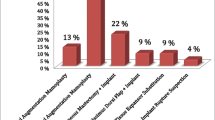Abstract
Background
The main complications of breast implantation are caused by capsular contracture and implant rupture. Although the evaluation of implant rupture is primarily driven by patient symptoms, including change in breast shape, size, or firmness, most patients with breast implant rupture do not clinically manifest significant symptoms, thereby developing a so-called silent rupture. For all these reasons, its diagnosis generally relies on imaging techniques such as mammography, ultrasound, and magnetic resonance imaging.
Methods
We conducted a retrospective non-randomized study, carried out between March 2013 and August 2017. In this study, we evaluated 30 symptomatic patients who underwent mono or bilateral prosthetic breast reconstruction, a total of 51 implants after skin-sparing mastectomy or nipple-sparing mastectomy for breast cancer and following breast implant removal or replacement due to suspicious rupture or capsule contraction.
Results
Ultrasound suspected ruptures in 32/51 (62.7%) implants, while 19/51 implants resulted intact upon ultrasound examination. The sensitivity and specificity of ultrasound were 90 and 80% respectively. Magnetic resonance imaging suspected ruptures in 30/51 (58.8%) implants, while 21/51 (41.1%) implants resulted intact. The magnetic resonance imaging sensitivity and specificity were 87 and 85%, respectively.
Conclusions
Ultrasound evaluation may be the first level exam in case of suspicious symptomatic breast implant rupture. Importantly, our results demonstrate that magnetic resonance imaging could be avoided in all those cases where an extracapsular rupture has been diagnosed using ultrasound.
Level of Evidence: Level IV, diagnostic study.






Similar content being viewed by others
References
Handel N, Garcia ME, Wixtrom R (2013) Breast implant rupture: causes, incidence, clinical impact, and management. Plast Reconstr Surg 132(5):1128–1137
Hölmich LR, Fryzek JP, Kjøller K, Breiting VB, Jørgensen A, Krag C, McLaughlin JK (2005) The diagnosis of silicone breast-implant rupture: clinical findings compared with findings at magnetic resonance imaging. Ann Plast Surg 54(6):583–589
Silicone GelFilled Breast Implants, FDA Recomendations 2006. https://www.fda.gov/MedicalDevices/ProductsandMedicalProcedures/ImplantsandProsthetics/BreastImplants/ucm064106.htm#Rupture_Silicone_Gel-Filled
Chung KC, Malay S, Shauver MJ, Kim HM (2012) Economic analysis of screening strategies for rupture of silicone gel breast implants. Plast Reconstr Surg 130(1):225–237
Vestito A, Mangieri FF, Ancona A, Minervini C, Perchinunno V, Rinaldi S (2012) Study of breast implant rupture: MRI versus surgical findings. Radiol Med 117(6):1004–1018
Gorczyca DP, Gorczyca SM, Gorczyca KL (2007) The diagnosis of silicone breast implant rupture. Plast Reconstr Surg 120(7 Suppl 1):49S–61S
Gray L (2008) Silicone breast implants and magnetic resonance imaging screening for rupture: do U.S. Food and Drug Administration recommendations reflect an evidence-based practice approach to patient care? Plast Reconstr Surg 122(5):1591–1592; author reply 1592
Brown SL, Middleton MS, Berg WA, Soo MS, Pennello G (2000) Prevalence of rupture of silicone gel breast implants revealed on MR imaging in a population of women in Birmingham, Alabama. AJR Am J Roentgenol 175(4):1057–1064
Reynolds HE, Buckwalter KA, Jackson VP, Siwy BK, Alexander SG (1994) Comparison of mammography, sonography, and magnetic resonance imaging in the detection of silicone-gel breast implant rupture. Ann Plast Surg 33:247–255 discussion 256–257
Huch RA, Kunzi W, Debatin JF, Wiesner W, Krestin GP (1998) MR imaging of the augmented breast. Eur Radiol 8:371–376
Pfleiderer B, Garrido L (1995) Migration and accumulation of silicone in the liver of women with silicone gel-filled breast implants. Magn Reson Med 33:8–17
Hold PM, Alam S, Pilbrow WJ, Kelly JF, Everitt EM, Dhital SK, Juma A (2012) How should we investigate breast implant rupture? Breast J 18(3):253–256
CM MC, Pusic AL, Kerrigan CL (2008) Silicone breast implants and magnetic resonance imaging screening for rupture: do U.S. Food and Drug Administration recommendations reflect an evidence-based practice approach to patient care? Plast Reconstr Surg 121(4):1127–1134
Lipworth L, Tarone RE, McLaughlin JK (2004) Silicone breast implants and connective tissue disease: an updated review of the epidemiologic evidence. Ann Plast Surg 52(6):598–601 Review
Hölmich LR, Friis S, Fryzek JP, Vejborg IM, Conrad C, Sletting S, Kjøller K, McLaughlin JK, Olsen JH (2003) Incidence of silicone breast implant rupture. Arch Surg 138(7):801–806
Lipworth L, Holmich LR, JK ML (2011) Silicone breast implants and connective tissue disease: no association. Semin Immunopathol 33(3):287–294
Colombo G, Ruvolo V, Stifanese R, Perillo M, Garlaschi A (2011) Prosthetic breast implant rupture: imaging—pictorial essay. Aesthet Plast Surg 35(5):891–900
Telegrafo M, Moschetta M (2015) Role of US in evaluating breast implant integrity. J Ultrasound 18(4):329–333 eCollection 2015 Dec
Author information
Authors and Affiliations
Corresponding author
Ethics declarations
Conflict of interest
Paolo Bogetti, Marco Fraccalvieri, Giovanni Cappello, Paolo Balocco, Giovanna Mariscotti, Manuela Durando, AntonGiulio Mangia, Anna Gianfala, Erind Ruka, and Stefano Bruschi declare that they have no conflict of interest.
Ethical approval
All procedures were in accordance with the ethical standards of the institutional research committee and with 1964 Helsinski declaration and its later amendments.
Informed consent
Patients provided consent before their inclusion in this study.
Disclosure
All authors disclose all relationships or interests that could influence or bias the work.
Rights and permissions
About this article
Cite this article
Bogetti, P., Fraccalvieri, M., Cappello, G. et al. Novel decision algorithm for the diagnosis of silicone gel breast implant ruptures. Eur J Plast Surg 41, 677–684 (2018). https://doi.org/10.1007/s00238-018-1434-z
Received:
Accepted:
Published:
Issue Date:
DOI: https://doi.org/10.1007/s00238-018-1434-z




